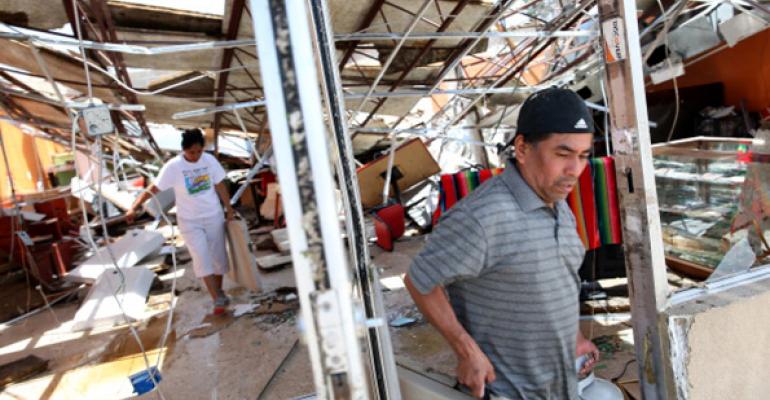No destructive hurricanes made landfall in the U.S. in 2013, and that lucky streak has held up through 2014 so far. But coastal-area restaurant operators still must be ready should one hit, just as operators elsewhere may have to deal with unexpected damage from a flood, tornado, forest fire or other natural disaster.
Where to start?
“The bulk of a restaurant operator’s storm preparation should happen before the storm appears on the radar screen,” said Beth Krantz of Cintas Managed Solutions. “You want to have the right partners and programs in place so once the evacuation notice is given, you have a turnkey response plan and can focus on other critical response items—like leaving town.”
Here the six questions Cintas suggests operators should ask when preparing for weather-driven disasters:
1. Do storefront windows have protective coating or shutters? If not, what are the board-up plans? Stores along seaboards or other areas regularly impacted by storms will likely have an additional layer of coating or shutters to protect glass from high winds. In situations where reinforced glass or shutters are not available, retailers should have an emergency-board-up plan in place. Because providers of these services will be overloaded during evacuation periods, it’s critical to have a partner in place and establish deadlines for having work completed.
2. When was your emergency plan last updated? Whether you created your emergency action plan six years or six months ago, you should review it before storm season to make sure it’s up to date. This includes confirming repair providers are still in business and able to perform the scope of work highlighted in your plan. In addition, you’ll want to review emergency action procedures, such as turning off gas and electric, or steps to secure refrigerated goods, with key personnel. Have a checklist available so team members can mark off each responsibility once it’s been completed.

3. What work scopes have been prepared for common emergency repairs after the storm passes? Typical storm damage repairs can extend from the store exterior (e.g. gutter or signage replacement) to the interior (e.g. plumbing backups or lighting replacements). Work with your emergency repair provider to identify your potential repair needs and develop work scopes to help expedite the repair process after the storm passes.
4. Are first-aid supplies regularly stocked in case an emergency occurs? Not all storms will force closures and emergency evacuations, so it’s important to be prepared in case a smaller storm causes unexpected damage. Having a stocked first-aid kit available helps limit the impact of an injury to retail staff or customers, enabling them to treat minor wounds and protect more serious wounds until they can receive further medical treatment.
5. When were emergency (egress) lights last tested? Most retailers don’t realize that the National Fire Prevention Association (NFPA) 101 regulation requires businesses to test emergency exit lights annually. This is to ensure that lights will maintain a 90-minute period of illumination during electrical outages or emergency situations. Make sure e-light testing is included in your preventive maintenance program.
6. Who is our emergency repair provider? If you don’t have an emergency repair provider in place, you should consider identifying a team that can provide round-the-clock board-up services and sandbag placement in preparation for the storm and assist with cleanup and repair tasks after the storm passes. From repairing broken entryways to extracting floors, you want a partner who can manage multiple facets of the cleanup operation so you can open your doors more quickly. Keep the contact’s landline and cell phone numbers readily accessible (store them in your cell phone or write them on a piece of paper) in case of an electricity outage and make sure they have all of your numbers, including ways to reach you after hours.
So who’s going to pay for all this? You may wish to query your insurance carrier about whether your current policy covers these weather-related contingencies. According to a new infographic provided by Insgroup, 65 percent of restaurant businesses are not protected if there is an interruption in operations.





